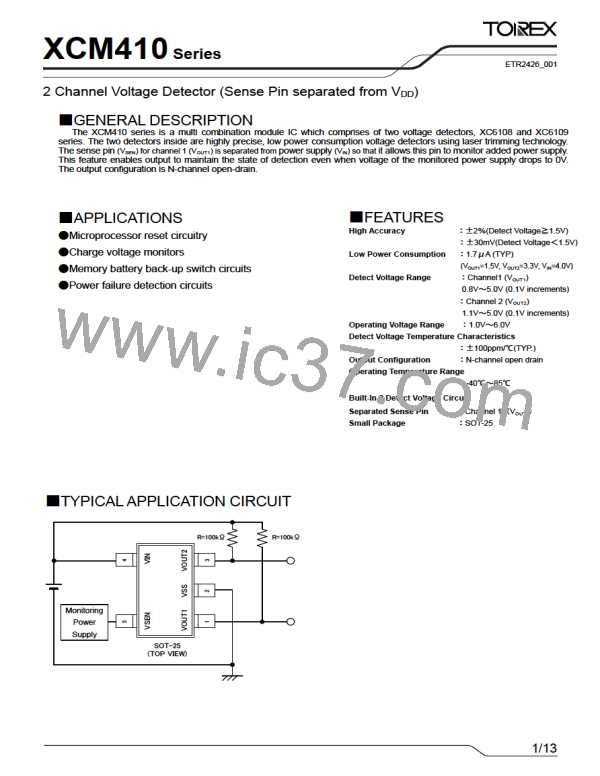XCM410
Series
■OPERATIONAL EXPLANATION (Continued)
⑤
⑥
The output voltage VOUT1 maintains high level (=VIN) while the sense pin voltage more than detect voltage (VSEN>VDF1).
The VIN input voltage pin is applied sufficiently high voltage to the release voltage (VDF2+VHYS2). While the input pin
voltage VIN starts dropping to the detect voltage VDF2 (VIN > VDF2), the output voltage VOUT2 keeps high level (=VIN).
* If a pull-up resistor of the N-ch open drain is connected to added power supply different from the input voltage pin, the
high level will be a voltage value where the pull-up resistor is connected.
⑦
When the input pin voltage keeps dropping and becomes equal to the detect voltage (VIN = VDF2), the output voltage
changes into low level (≦VIN×0.1). The detect delay time tDF2 is defined as time which ranges from VIN =VDF to the VOUT
goes in low level.
⑧
⑨
While the input pin voltage keeps below the detect voltage VDF2, and 1.0V or more, the output voltage VOUT2 maintains low
level.
While the input pin voltage drops to 1.0V or less and it increases again to 1.0V or more, the output voltage (VOUT2) may not
be able to maintain low level. Such an operation is called “Undefined Operation”, and the output voltage from the VOUT2 pin
is called undefined operating voltage VUNS
.
⑩
⑪
While the input pin voltage increases from 1.0V to the release voltage level (VIN<VDF2 +VHYS2), the output voltage (VOUT2)
maintains low level.
The release delay time tDR2 is defined as time which ranges from the VIN power supply voltage pin reaches release voltage
(VIN≧VDF2+VHYS2) to the VOUT2 goes in high level.
⑫
⑬
The output voltage VOUT2 maintains high level (=VIN) while the power supply voltage more than detect voltage (VIN>VDF2).
If a pull-up resistor Rpull1 of the N-ch open drain is connected to power supply VIN, output voltage VOUT1 becomes same to
the input voltage VIN. While the VIN power supply voltage drops below 1.0V and increases again to 1.0V or more, the
output voltage VOUT2 may not be able to maintain low level.
7/13

 TOREX [ Torex Semiconductor ]
TOREX [ Torex Semiconductor ]